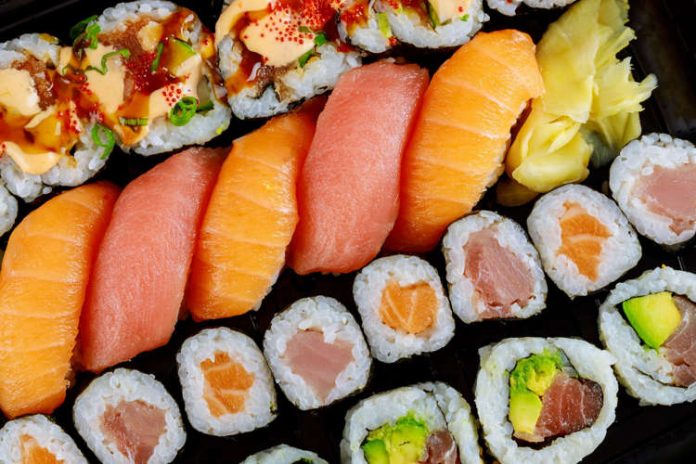Effects of high mercury exposure include neurodevelopmental deficits, poor cognition and heart disease
Fish contains omega-3 (n-3) fatty acids that reduce cholesterol levels, reduce risk of some cancers and reduce the incidence of heart disease, blood pressure, stroke, and pre-term delivery. Methylmercury may counter some of the cardio protective effects of omega-3 fatty acids and based on data from the National Health and Nutrition Examination Survey, 7.8–15% of fetuses in the USA have excessive mercury exposure.
Consumption of sushi and related dishes, traditionally considered a Japanese specialty product, has increased greatly in the USA and other countries, with these foods now widely available in grocery stores, lunch counters, as well as specialty restaurants and sushi bars. Although there is a growing trend for the consumption of sushi there is very little quantitative data on either consumption patterns of sushi, or contaminants in sushi.
In a new study, researchers examine the consumption of fish and specifically fish-sushi in terms of meals per month, and the number of all sushi and fish-sushi pieces per meal, linked to data on total mercury levels in different components of sushi.
For this study researchers interviewed 1,289 people in a New Jersey university community regarding fish and sushi consumption and collected ‘sushi’ samples for total mercury analysis from New Jersey stores and supermarkets and from New York City, and Chicago. People were asked about the number of fish meals a month, number of fish-sushi and non-fish-sushi meals a month, and the number of sushi pieces and fish-sushi pieces consumed at a typical sushi meal.
Researcher’s analyzed total mercury, recognizing that on average about 90% of the mercury in fish is methylmercury and used that percentage to convert total mercury concentration data to an estimate of methylmercury intake and risk.
The researchers reported that among the respondents a mean average of 4.7 fish meals was consumed per month. Of the 92% who reported eating any fish or fish-sushi, the average was 5.1 meals per month. Of the 77% who reported eating any sushi, the average was 3.3 sushi meals per month, almost all of which included fish-sushi. However, 8% of sushi eaters ate only vegetarian sushi. At a meal, the sushi eaters averaged 8.5 sushi pieces of which 7.4 were fish-sushi. For each individual, we multiplied their reported fish-sushi pieces per meal times their fish-sushi meals per month to arrive at an average of 27.0 fish-sushi pieces per month.
Researchers found higher levels of mercury in tuna sushi from sushi specialty shops compared with sushi purchased at grocery fish counters.
total mercury levels in both tuna roll and sashimi were sufficiently high to suggest that sensitive populations would be at risk from frequent consumption of sushi, as represented by the high-end fish-sushi consumers in this study. There was great variation in mercury levels in tuna, with some levels as high as 2.0 ppm, which makes exposure to mercury from consumption of sushi or sashimi less predictable. Some sushi grade tuna clearly exceed the US Food and Drug Administration action level of 1 ppm, and well over half the tuna in sushi exceed the international regulatory level of 0.5 ppm, and the average is higher than levels reported on the FDA website.
The top 10% of all participants from across all ethnic groups exceeded the Center for Disease Control Minimal Risk Level and the World Health Organization Provisional Tolerable Weekly Intake of methylmercury.
The large tuna such as Bluefin, which are prized for sushi, have the highest mercury levels and are also the most endangered by overfishing.
In their discussion the researchers write “For people who eat fish or fish-sushi infrequently (less than monthly), the choice of which fish to eat regarding mercury content is probably not important. People, who eat fish frequently, more than weekly, must choose wisely. High-end sushi eaters should minimize intake of tuna. Salmon is much lower in mercury, although farmed salmon entails other ecological problems.”
“It is important to point out that as fish consumption in general, and sushi consumption in particular is on the rise, the basic resource, the fish are not. Fish populations, even in the ocean, are being depleted. Moreover, the growing appetite for sushi, particularly in Japan, has placed sushi-grade tuna species and particularly the Atlantic Bluefin Tuna in jeopardy.”
“Further, the data clearly indicate that risk assessors and managers need to take sushi consumption into account when dealing with the risk from mercury in fish.”








